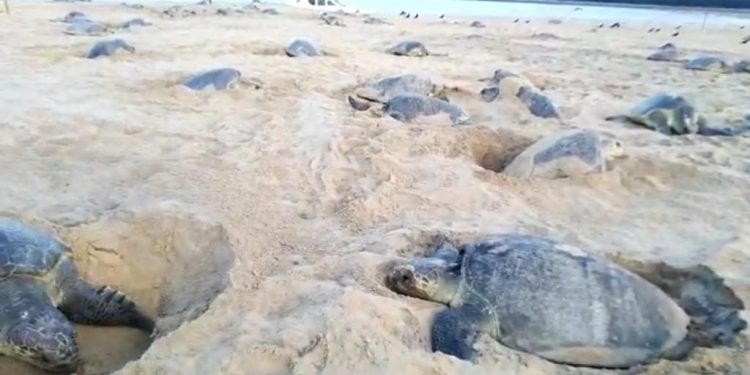Kendrapara: Olive Ridley sea turtles have begun emerging on the sea waters off Gahirmatha along the Odisha coast, marking the commencement of the annual mass nesting of these endangered marine species. Gahirmatha in Kendrapara district, 150 km from the Capital city of Bhubaneswar, is the world’s largest rookery for Olive Ridley sea turtles. Forest personnel on patrolling drives have sighted pairs of mating turtles. For undisturbed breeding of the aquatic animals, prohibition on sea fishing continues to remain in force in the marine sanctuary, said forest officials.
Apart from Gahirmatha, these threatened aquatic animals turn up at Rushikulya river mouth in Ganjam district and the Devi river mouth in Puri district for mass nesting. On the serene surface of sea waters, the turtle surveying teams spotted hundreds of mating pairs along the Gahirmatha coast. After the end of the mating season, most of the male turtles usually return leaving behind the female turtles to lay their eggs, Gahirmatha forest range officer, Manas Das, said. The female turtles virtually invade the nesting beaches usually in the dead of the night for laying eggs, the phenomenon otherwise described as ‘arribada’. The turtles then leave the nesting ground to stride into the deep seawater.
Hatchlings emerge from these eggs after 45-60 days. It is a rare natural phenomenon where the babies grow without their mother, the forest officer added. An estimated eight lakh female turtles had turned up to dig pits and lay millions of eggs on the nesting beaches in Odisha in February-March this year, he said.
The ban on fishing remains in force throughout the year in Gahirmatha marine sanctuary as the seawater here is the most conducive habitat for these delicate marine species. A rise in the mortality rate of mating turtles along the coastal water surface led to the clamping of prohibition as the gill nets used by the trawls prove to be messengers of death for breeding turtles. The Olive Ridley sea turtles, accorded a Schedule-1 animal category under the Wildlife (Protection) Act for their highly threatened status, get entangled in the nets for prolonged periods and die of asphyxiation.
The turtles also perish in large numbers after getting hit by the fast-moving propeller of the fishing trawlers, forest personnel said. The rate of mortality of these endangered species is quite high. An Olive Ridley sea turtle usually lays about 120 to 150 eggs from which hatchlings emerge after about 45 to 60 days. But not all eggs remain intact as predators devour them. Besides, eggs are also washed away by waves during high tide.






































